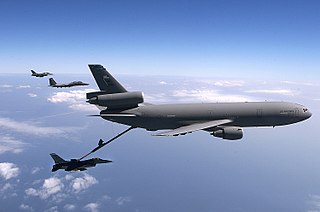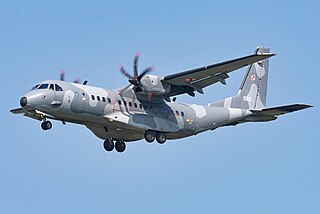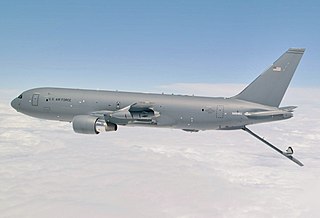Related Research Articles

Air Force One is the official air traffic control-designated call sign for a United States Air Force aircraft carrying the president of the United States. The term is commonly used to denote U.S. Air Force aircraft modified and used to transport the president, and as a metonym for the primary presidential aircraft, VC-25, although it can be used to refer to any Air Force aircraft the president travels on.

The Eurofighter Typhoon is a European multinational twin-engine, supersonic, canard delta wing, multirole fighter. The Typhoon was designed originally as an air-superiority fighter and is manufactured by a consortium of Airbus, BAE Systems and Leonardo that conducts the majority of the project through a joint holding company, Eurofighter Jagdflugzeug GmbH. The NATO Eurofighter and Tornado Management Agency, representing the UK, Germany, Italy and Spain, manages the project and is the prime customer.

A supersonic transport (SST) or a supersonic airliner is a civilian supersonic aircraft designed to transport passengers at speeds greater than the speed of sound. To date, the only SSTs to see regular service have been Concorde and the Tupolev Tu-144. The last passenger flight of the Tu-144 was in June 1978 and it was last flown in 1999 by NASA. Concorde's last commercial flight was in October 2003, with a November 26, 2003 ferry flight being its last flight.

The Bangladesh Air Force (BAF) is the aerial warfare branch of the Bangladesh Armed Forces. The air force is primarily responsible for air defence of Bangladesh's sovereign territory as well as providing air support to the Bangladesh Army and Bangladesh Navy. Furthermore, the BAF has a territorial role in providing tactical and strategic air transport and logistics capability for the country.

The McDonnell Douglas KC-10 Extender is an American tanker and cargo aircraft that was operated by the United States Air Force (USAF) from 1981 to 2024. A military version of the three-engine DC-10 airliner, the KC-10 was developed from the Advanced Tanker Cargo Aircraft Program. It incorporates military-specific equipment for its primary roles of aerial refueling and transport. It was developed to supplement the KC-135 Stratotanker following experiences in Southeast Asia and the Middle East. The KC-10 was the second McDonnell Douglas transport aircraft to be selected by the Air Force following the C-9. A total of 60 KC-10s were produced for the USAF. The Royal Netherlands Air Force operated two similar tankers designated KDC-10 that were converted from DC-10s.

The Boeing C-32 is the United States Air Force designation for variants of the Boeing 757 in military service. Two variants exist, filling different parts of the military passenger transport role. The C-32A serves the Special Air Mission, providing executive transport and broad communications capabilities to senior political officials, while the C-32B Gatekeeper provides clandestine airlift to special operations and global emergency response efforts, a role known as "covered air".

The Airbus A330 Multi Role Tanker Transport (MRTT) is a European aerial refueling and military transport aircraft based on the civilian Airbus A330. A total of 15 countries have placed firm orders for approximately 82 aircraft, of which 62 had been delivered by 31 December 2024. A version of the A330 MRTT, the EADS/Northrop Grumman KC-45, was selected by the United States Air Force for its aerial tanker replacement programme, but the programme was cancelled.

The General Command of the Air Force also referred to as the Islamic Emirate Air Force and the Afghan Air Force, is the air force branch of the Afghan Armed Forces.
Aerion Corporation was an American aircraft manufacturer based in Reno, Nevada. It was founded by Robert Bass of Fort Worth.

The Airbus C295 is a medium tactical transport aircraft that was designed and initially manufactured by the Spanish aerospace company CASA, which is now part of the European multinational Airbus Defence and Space division.

The KAI KF-21 Boramae is a South Korean-led fighter aircraft development program with the goal of producing an advanced multirole fighter for the South Korean and Indonesian air forces. The airframe uses stealth technology but carries weapons externally, and features such as internal bays will be introduced later with KF-21EX program. The KAI KF-X is South Korea's second domestic fighter jet development program, following the FA-50.

The planning for the future of the Royal Air Force involves supporting ongoing British military operations and the introduction of new aircraft types including unmanned aerial vehicles and the BAE Systems Tempest sixth-generation fighter in the 2030s. Priorities include greater focus on network enabled capability and mixing crewed fighter jets with UAVs and swarming drones. The new initiative will focus on increasing interoperability with members of NATO and becoming carbon net-zero, with strategies such as using sustainable aviation fuels in aircraft.

The Boeing KC-46 Pegasus is an American military aerial refueling and strategic military transport aircraft developed by Boeing from its 767 jet airliner. In February 2011, the tanker was selected by the United States Air Force (USAF) as the winner in the KC-X tanker competition to replace older Boeing KC-135 Stratotankers. The first aircraft was delivered to the USAF in January 2019. The USAF intends to procure 179 tankers by 2027.

The Aerion AS2 was a proposed supersonic business jet that was being developed by Aerion Corporation. In May 2014, it was announced that the Aerion AS2 would be part of a larger Aerion SBJ redesign, which aimed for release after a seven-year developmental period. Aerion partnered with Airbus in September the same year. In December 2017, Airbus was replaced by Lockheed Martin. Its General Electric Affinity engine was unveiled in October 2018. In February 2019, Boeing replaced Lockheed Martin. Development stopped when Aerion ceased operations in May 2021.
The PAK VTA is a Russian next-generation heavy military transport aircraft, currently under development by Ilyushin.

The Lockheed Martin X-59 Quesst, sometimes styled QueSST, is an American experimental supersonic aircraft under development by Skunk Works for NASA's Low-Boom Flight Demonstrator project. Preliminary design started in February 2016, with the X-59 planned to begin flight testing in 2021. After delays, as of January 2025, it is planned to be delivered to NASA for flight testing in 2025. It is expected to cruise at Mach 1.42 at an altitude of 55,000 ft (16,800 m), creating a low 75 effective perceived noise level (EPNdB) thump to evaluate supersonic transport acceptability.
Boom Technology, Inc. is an American company designing a supersonic airliner named the Overture. The company is also flight-testing their one-third-scale demonstrator: the Boom XB-1 "Baby Boom". On January 28, 2025, the company broke the sound barrier for the first time with its new XB-1 aircraft, after taking off from the Mojave Air and Space Port.

The Boom XB-1 "Baby Boom" is a one-third-scale trijet supersonic demonstrator designed by Boom Technology as part of the development of the Boom Overture supersonic transport airliner. Powered by three General Electric CJ610 engines, it is designed to maintain Mach 2.2, with over 1,000 nautical miles of range. The XB-1 began taxi tests in December 2022, and conducted its maiden flight on March 22, 2024. The aircraft performed its first supersonic flight test on January 28, 2025.

The Boom Overture is a supersonic airliner under development by Boom Technology, designed to cruise at Mach 1.7 or 975 knots. It will accommodate 64 to 80 passengers, depending on the configuration, and have a range of 4,250 nautical miles. Boom Technology aims to introduce the Overture in 2029. The company projects a market for up to 1,000 supersonic airliners, serving 500 viable routes, with fares comparable to business class. Featuring a delta wing design reminiscent of the Concorde, the Overture will utilize composite materials in its construction. A 2022 redesign specified four dry (non-afterburning) turbofan engines, each producing 160 kilonewtons of thrust.
Hermeus Corporation is an American startup company designing a hypersonic airliner.
References
- ↑ Schuurman, Richard (25 September 2019). "Exosonic hopes to find low-boom SST-niche » AirInsight". AirInsight. Retrieved 6 September 2020.
- ↑ Exosonic (2024-11-08). "Exosonic Announces That the Company Is Undergoing the Shutdown Process". Exosonic. Retrieved 2024-11-28.
- ↑ "Company". Exosonic. Retrieved 2023-05-03.
- ↑ Pawlyk, Oriana (1 September 2020). "Military Moves Forward with Plan to Make Air Force One Supersonic". Military.com. Retrieved 7 September 2020.
- ↑ www.exosonic.com https://www.exosonic.com/ . Retrieved 7 September 2020.
{{cite web}}: Missing or empty|title=(help) - ↑ Hutson, Matthew. "Will We Ever Fly Supersonically Over Land?". The New Yorker. Retrieved 11 July 2021.
- ↑ "Pentagon takes first step toward building supersonic Air Force One". The Washington Times. Retrieved 7 September 2020.
- ↑ Niles, Russ (6 September 2020). "Air Force Eying Supersonic Air Force One". AVweb. Retrieved 7 September 2020.
- ↑ "Exclusive look at designs for US supersonic presidential jet". CNN . 2 April 2021.